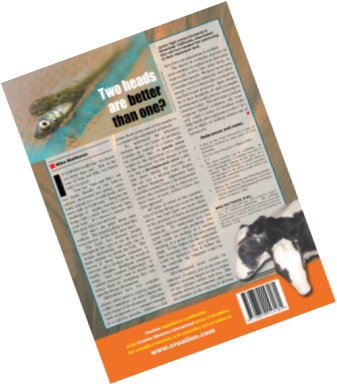Two heads are better than one?

It’s often said that ‘two heads are better than one’. But, in the case of Sam and Ella, two heads aren’t so good.
You see, ‘Sam and Ella’1 are two heads literally on one fish—a salmon, discovered last spring, swimming around in a seventh-grade classroom tank in California.2 Imagine the challenge of flopping around a watery home with a head that’s heavier than your body. It’s almost a miracle that this poor fish even survived.
And that’s the point about such oddities. The amazing thing is that they even survive. In the wild, most don’t.
The Lord has allowed people throughout the ages to see all sorts of strange deformities, and each one of them reminds us about the Fall. The lesson of these bizarre creatures is obvious: life’s designs are the result of highly complex, intelligent programming. And ‘random happenings’ or ‘natural processes’ tend to distort and deface them by disrupting this very specific design information.
Deformities have two common causes: either genetic copying mistakes (called ‘mutations’) or errors during the early stages of development.3 Albinism (lack of pigment) is a common example of a copying mistake, whereas a cleft palate (hole in the roof of the mouth) is a common developmental deformity.
To understand the difference between these two types of problems, consider an analogy to a motor vehicle assembly line. A genetic error would be the equivalent of a mistake in the blueprint for the design of the car, but a developmental error could take place during the assembly of the car (e.g. a missing bolt), despite a perfect blueprint. Apparently Sam and Ella resulted from a developmental error—the fertilized egg is believed to have been severely jostled before the eyes appeared.4
All types of errors in the construction of living things can occur by themselves, but both types are more likely in the presence of harsh environmental influences, such as radiation and certain chemicals. To understand how one agent could cause both problems, you could make an analogy to a random shooting at a motor car manufacturing plant. If the bullets hit the equipment that assembles the cars, new products could be defective, but if bullets hit the databank, the blueprint could be corrupted.
Developmental errors cannot be inherited, of course, just as one does not inherit a missing finger (or rib) if either of one’s parents suffers such loss. But genetic defects are inherited, since they are mistakes in the copying of information from one generation to another.
The theory of evolution depends on such mistakes to explain how dinosaurs supposedly evolve into dodo birds, or prawns into people. We have never seen a mistake that has added any new information, yet if evolution has occurred by neo-Darwinian processes, there should be at least hundreds of such examples evolutionists could point to occurring in creatures today. The next time you hear someone defend evolution, ask yourself: could a series of mistakes really help totally new organisms evolve? It’s just as likely as making salmon out of Salmonella.
References and notes
- A play on the word Salmonella, a type of bacterium involved in some cases of food poisoning. Return to text.
- The Cincinnati Enquirer, 4 March 2002, p. 2. Return to text.
- The term mutation can be confusing. In everyday language, a mutation can refer to any significant ‘change in the form’ of a creature. But in biology, it strictly refers to ‘an alteration in the genes’ of an organism. Technically, mutations are genetic errors, not developmental errors. Return to text.
- Nelson, M., Two heads are better than chum, The Sun, Bremerton, Washington, www.thesunlink.com/news/2002/january/01183chum.html, 18 January 2002, available via web.archive.org. Return to text.


Readers’ comments
Comments are automatically closed 14 days after publication.